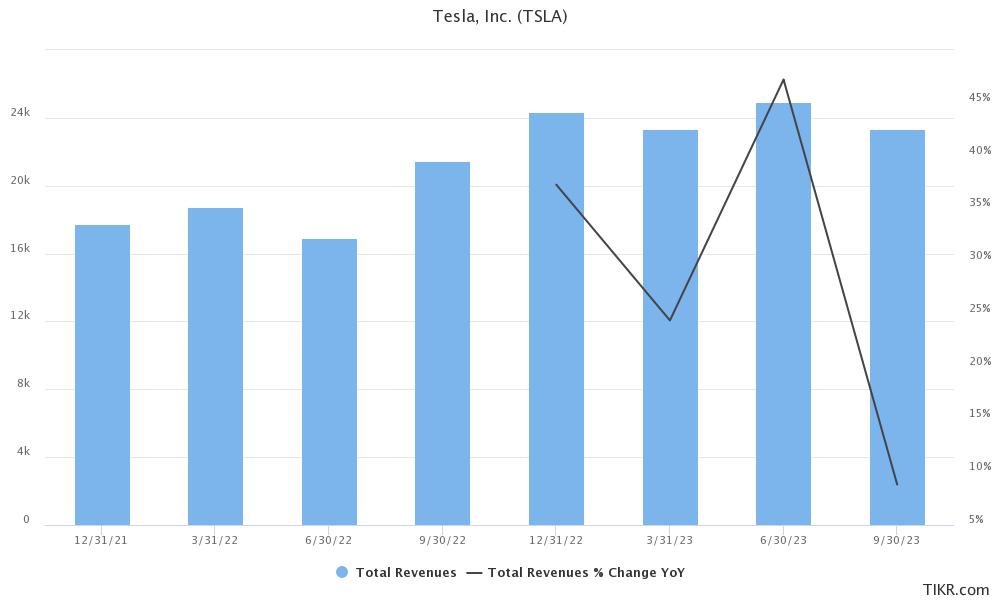Tesla Stock Falls to Multi-Month Lows Amid EV Demand Worries
Please note that we are not authorised to provide any investment advice. The content on this page is for information purposes only.
Tesla stock (NYSE: TSLA) closed below $200 yesterday and fell to a five-month low amid worries over the electric vehicle (EV) demand environment. The stock has lost over 18% since it reported its Q3 earnings where it missed both topline and bottomline estimates.
Yesterday, Panasonic cut the outlook for its battery unit citing a slowdown in sales of high-end EVs in the U.S. Notably, higher-priced EVs don’t qualify for the EV tax credit under the Inflation Reduction Act and Tesla’s Model X and Model Y are not eligible for the tax credit.
However, these two models account for less than 5% of Tesla’s total deliveries. Most of Tesla’s sales come from Model Y and Model 3 and all the variants of these two models are eligible for the $7,500 tax credit.
Analysts get jittery about the demand for Tesla cars
Meanwhile, some analysts fear that tepid demand for Tesla vehicles is leading to lower demand for silicon carbide products from On Semiconductor. In his note, Truist’s William Stein said, “ON highlighted weak demand for SiC products at a single EV customer (we strongly suspect Hold-rated TSLA) and weak demand at multiple European tier-1 suppliers, indicating a slowdown in semi demand at [internal combustion engine]-autos as well.”
Bank of America’s Vivek Arya also believes that Tesla is the culprit for the cancelation of silicon carbide orders. He said in his note, “EV market is currently under pressure, but we still see it as a double-digit growth market … with chipmakers such as ON driving ~2x content/car compared to ICE.”
Musk on EV demand environment
Meanwhile, Tesla has also sounded circumspect on the EV demand environment during the Q3 earnings call and its CEO Elon Musk said, “we’re laying the groundwork to begin construction and doing all the long lead items, but I think we want to just get a sense for the global economy is like before we go full tilt on the Mexico factory.”
He added, “I am worried about the high interest rate environment that we’re in. I just can’t emphasize this enough, that the vast majority of people buying a car is about the monthly payment. And as interest rates rise, the proportion of that monthly payment that is interest increases naturally.”
Previously also Musk has talked about the possibility of a recession and blamed the Fed’s rate hikes for worsening the economic slowdown.
EV companies raise alarm over demand
In July, Ford toned down its ambitious EV program and said that it would hit an annual production capacity of 600,000 by 2024 instead of 2023. It also rolled back the targeted production capacity of 2 million cars and said that it would be “flexible” about the timing – instead of reaching the goal in 2026 as previously stated.
During the Q3 earnings call, Ford’s CFO John Lawler said, “The transition to EVs is well underway. Adoption is growing, even if pace is slower than what the industry, including us, expected.”
He added, “Along the way, we’re going to balance production of gas, hybrid and electric vehicles in ways that many companies can’t, based on what consumers want.”
According to Lawler, “Given the dynamic EV environment, we are judicious about our production.”
Ford would also delay its planned $12 billion investments towards building electric cars and also postpone the construction of the EV battery plant in Kentucky. Rival General Motors has also scaled back its EV plans and has delayed the production of electric trucks at the Orion assembly plant until late 2025.
The EV price war has escalated
Notably, the EV price war has escalated this year after Tesla lowered car prices in the US towards the beginning of the year itself. The Elon Musk-run company has cut prices several times over the last year which has triggered an industrywide price war.
After this round of price cuts, Tesla’s website lists the starting price for the Model 3 at $38,990 while the Model Y at $45,990. After these price cuts, Tesla has lowered the prices of the Model 3 standard version by almost 17% in the US since the beginning of the year.
Other automakers have followed suit and have lowered car prices to remain competitive.
Tesla bears sense an opportunity
Amid the fall in Tesla’s margins and concerns over the EV demand environment, many analysts are now getting concerned about Tesla stock. Last week, Bernstein which has been a long-time Tesla bear reiterated the stock as an underperform and said, “We continue to believe that Tesla is a car company, and that the competitive nature of the auto industry (which is becoming increasingly competitive and global) will make it difficult for any player to have a sustained cost or profitability advantage.”
The brokerage doubled down on its bearish stance and said yesterday “While we have more confidence in our ability to call the fundamentals than the short term price moves, we note that the setup for the stock appears similar to October of last year, and arguably, the outlook for T+2 (i.e., FY 2025) and beyond appears more uncertain than a year ago.”
Tesla’s Cybertruck woes
Tesla’s upcoming Cybertruck should help it buoy its delivery numbers but during the Q3 earnings call, Musk sounded quite circumspect about the pickup model and said, “we dug our own grave with the Cybertruck.”
He added, “It’s a great product, but financially, it will take, I don’t know, a year to 18 months before it is a significant positive cash flow contributor.”
Tesla delivery guidance
Meanwhile, Tesla maintained the 2023 delivery guidance of 1.8 million but did not provide a guidance for 2024 saying it would do so at the next earnings call.
Tesla has set itself a target of producing 20 million cars annually by 2030. To put that in perspective, Toyota, the world’s largest automaker, sold just over 10 million cars in 2022.
To achieve the goal of 20 million deliveries, which amounts to a CAGR of over 41% between 2023 and 2030, Tesla might need to build many more Gigafactories. In the past, Musk said that the company would need over a dozen Gigafactories to reach that goal.
However, with there being serious concerns over EV demand it remains to be seen whether Tesla reaches anywhere near the ambitious targets.






